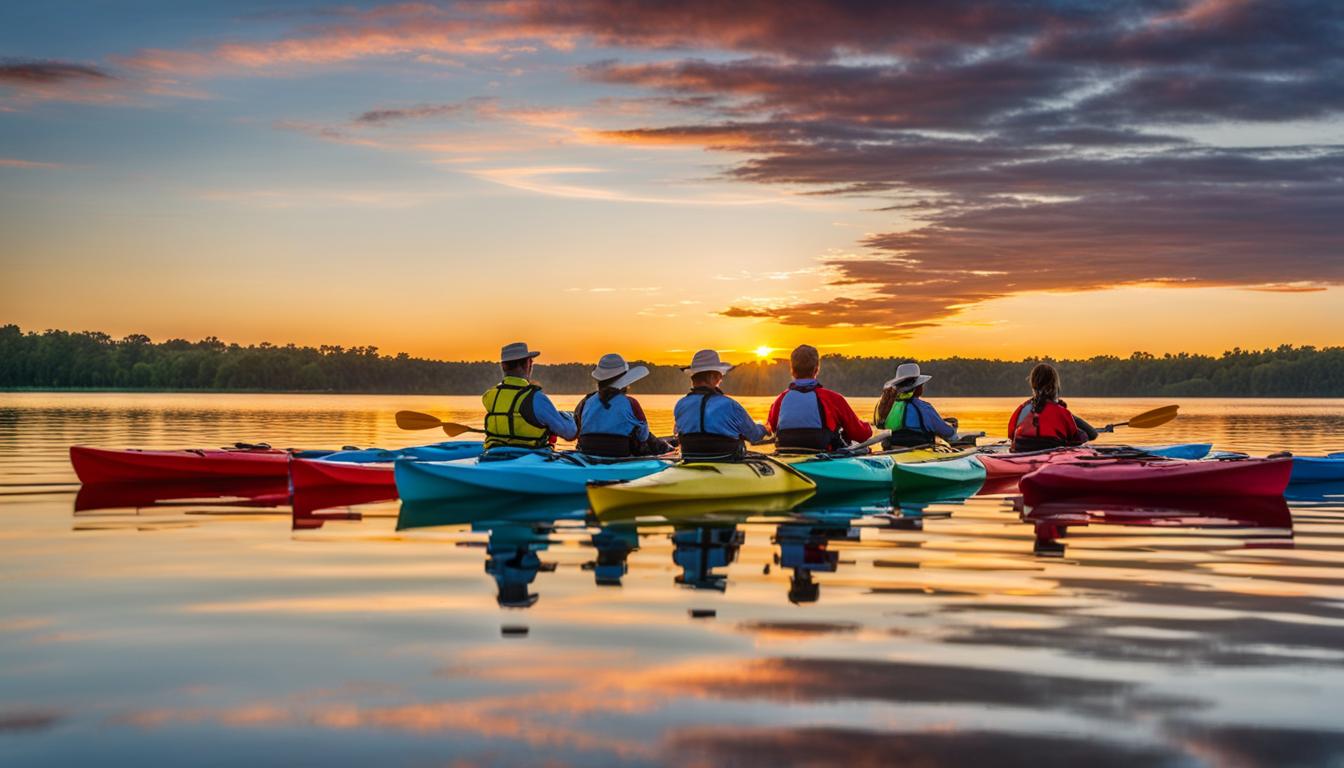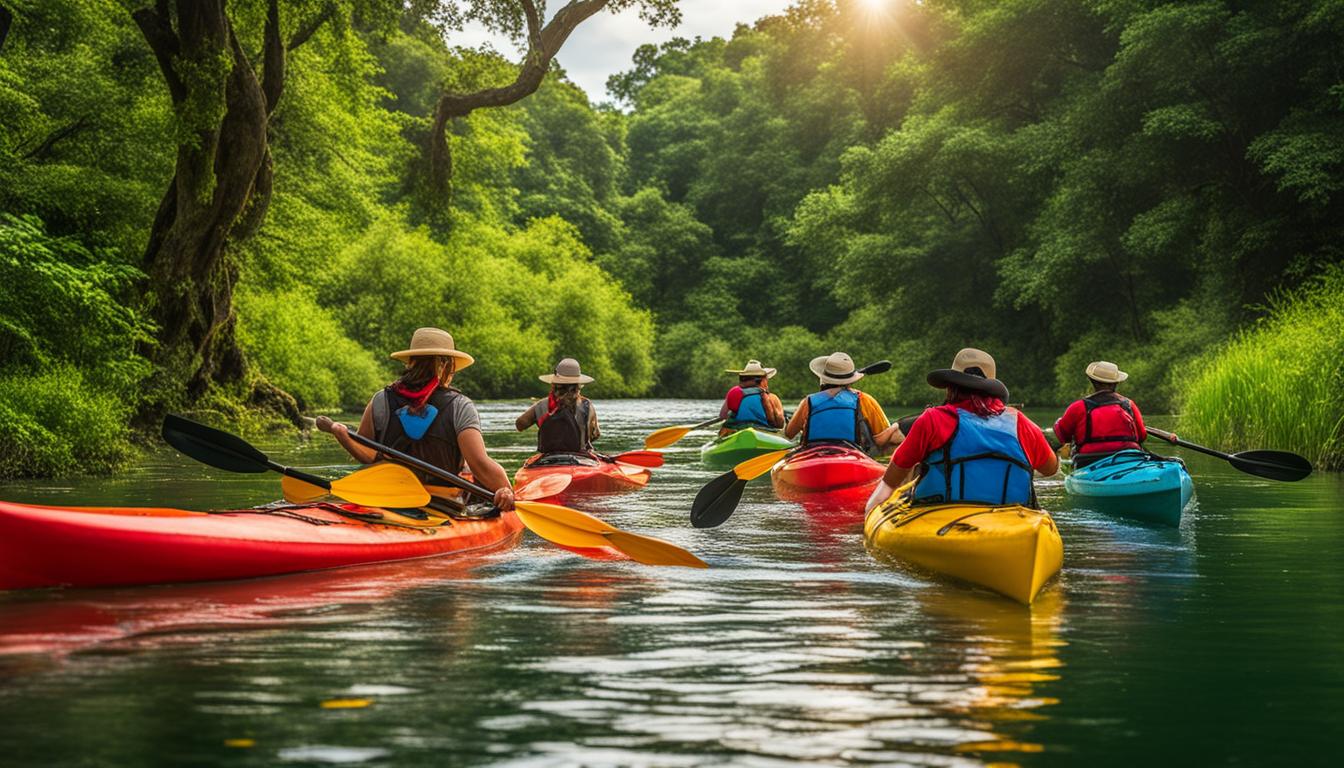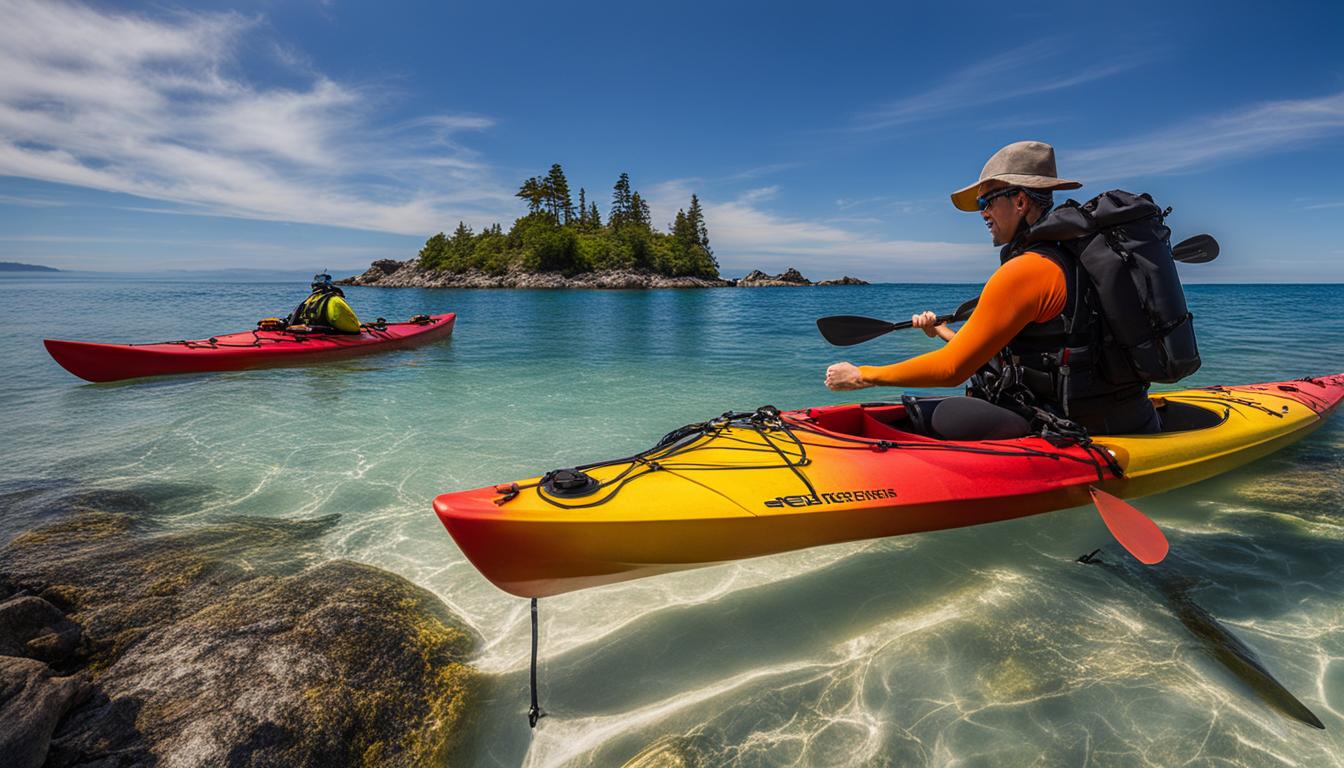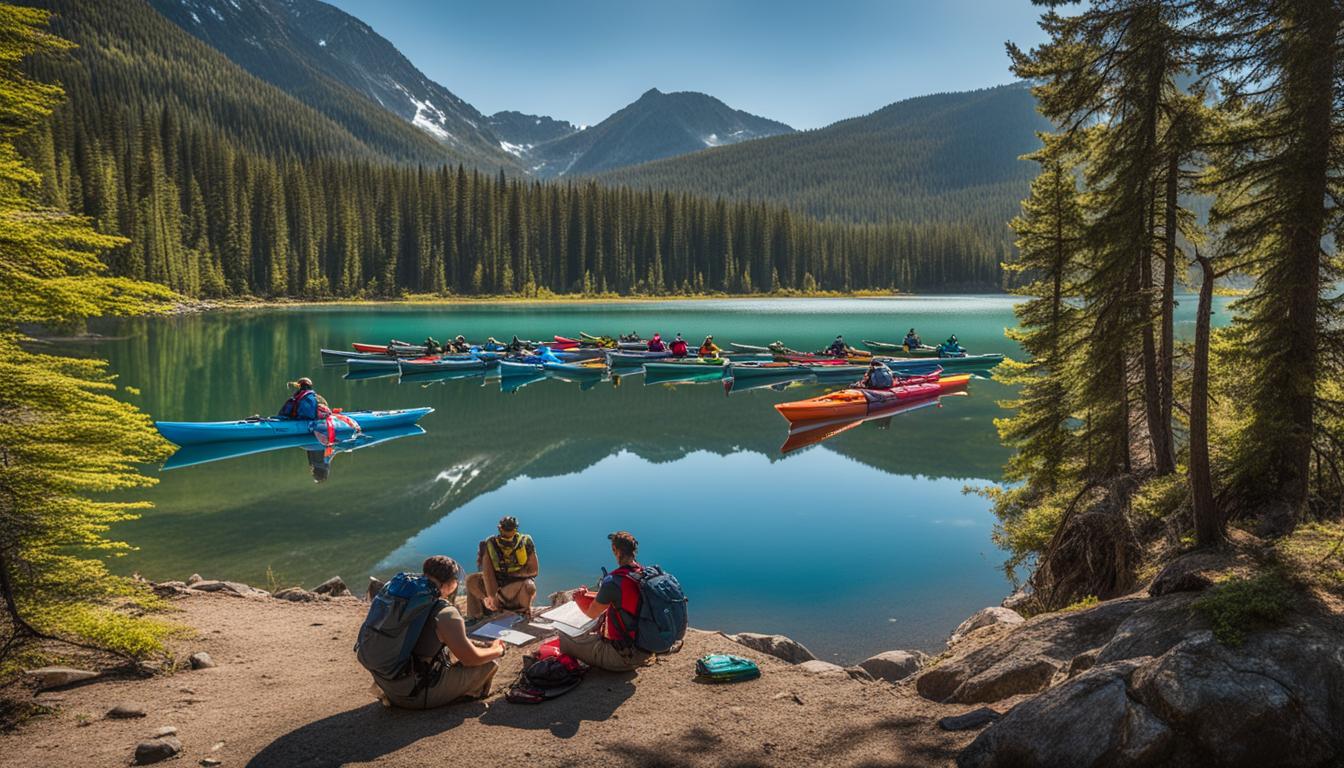Are you an avid photographer looking to capture breathtaking moments while exploring the beauty of nature on kayak tours? Look no further! In this section, we will provide you with essential photography tips and techniques that will help you take your kayak tour photography to the next level.
When it comes to photography on kayak tours, there are a few key aspects to consider. First and foremost, your safety should always be a top priority. Additionally, choosing the right camera and mastering composition techniques will greatly enhance your photography experience.
To ensure your photographs truly shine, pay attention to the lighting conditions, experiment with angles and perspectives, and include elements such as fellow paddlers and the bow of your boat in your composition. By following these tips, you’ll be well on your way to capturing stunning shots that will leave a lasting impression.
Key Takeaways
- Choose safe environments and have necessary safety equipment.
- Keep your camera dry by using a waterproof case or compartment.
- Consider using a smartphone with a waterproof case or a DSLR camera.
- Pay attention to composition by including elements like fellow paddlers and the bow of your boat.
- Experiment with angles and perspectives to add depth to your photos.
Ensuring the Safety of Your Camera Equipment on Kayak Tours
When embarking on a kayak tour, it’s crucial to prioritize the safety of your camera equipment. Protecting your gear from water damage and ensuring its stability on the kayak are key considerations. By following these tips, you can enjoy your photography experience without worrying about potential mishaps.
Protecting Your Camera Equipment
To safeguard your camera equipment from water damage, invest in a reliable dry bag or a waterproof case. These protective accessories will keep your gear safe from splashes and accidental submersion. Additionally, consider using a strap or leash to secure your camera to your body or kayak. This will prevent accidental drops or loss during unexpected movements.
It’s also recommended to use additional padding or towels to provide extra cushioning for your equipment. This will minimize the impact of potential bumps or jolts while paddling. Furthermore, wiping off any water splashes on your camera and using a UV or polarizing filter can help protect your lens from moisture and enhance the quality of your photos.
Tips for Stable Photography on Kayaks
To ensure stable photography on kayaks, choose a kayak model that offers stability. A stable kayak will minimize camera shake caused by the natural movement of the water. This is particularly important when capturing photos in challenging conditions or while on the move.
When photographing from a kayak, it’s crucial to be mindful of your surroundings and approach wildlife with caution. Avoid sudden movements or loud noises that may startle the animals. Respecting their space and observing from a distance will allow you to capture their natural behavior without causing any disturbance.
| Tips for Protecting Camera Equipment on Kayak Tours | Tips for Stable Photography on Kayaks |
|---|---|
| Use a dry bag or waterproof case | Choose a stable kayak model |
| Secure your camera with a strap or leash | Be mindful of your surroundings |
| Provide additional padding or towels for protection | Approach wildlife with caution |
| Wipe off splashes and use a UV or polarizing filter | Avoid sudden movements or loud noises |
By implementing these measures, you can confidently capture stunning shots during your kayak tour, knowing that your camera equipment is secure and stable. Remember to keep safety as your top priority while enjoying the breathtaking beauty of nature.
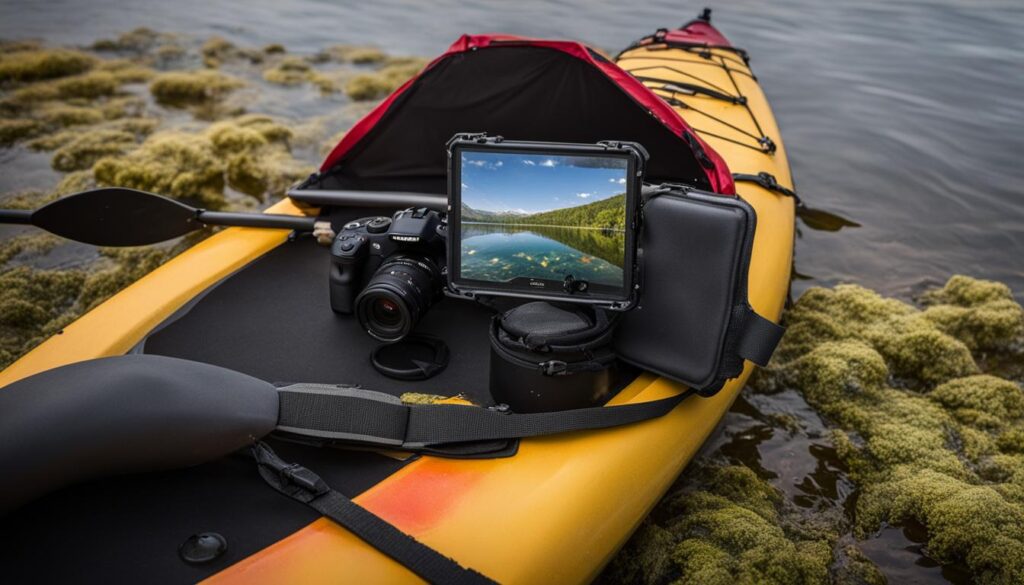
Composition Tips for Capturing Stunning Kayak Tour Photos
When it comes to photographing kayak tours, composition plays a crucial role in creating visually appealing and captivating images. By following a few composition tips, you can take your kayak tour photos to the next level and capture stunning shots that tell a story. Here are some creative kayak tour photography ideas to inspire you:
Include Elements of the Kayak Tour
An effective way to create engaging kayak tour photos is to include elements that are unique to the experience. Incorporate fellow paddlers in your frame to add a sense of scale and create a dynamic composition. Capture the beauty of the surrounding scenery, whether it’s the shimmering water, lush plant life, or towering cliffs.
Create Leading Lines and Depth
Utilize the bow of your kayak to create leading lines that draw the viewer’s eye into the scene. This can add depth and guide the viewer’s gaze through the image. Experiment with different angles and perspectives to add visual interest and tell a compelling story. Consider capturing underwater views to add a unique perspective and a sense of wonder.
Showcase Your Kayak
Develop a recognizable style by featuring the front of your kayak in your photos. This can help create a personal connection between the viewer and the image. Experiment with different angles and compositions to showcase the shape and color of your kayak. By including your kayak in your photos, you can add a sense of adventure and make your images stand out.
Remember, the key to capturing stunning kayak tour photos is to experiment, be creative, and pay attention to composition. By incorporating these composition tips into your photography, you can elevate your images and create memorable visuals that truly capture the essence of your kayak tour.

Choosing the Right Camera for Kayak Photography
When it comes to capturing stunning photos on your kayak tours, choosing the right camera is crucial. Whether you prefer using a smartphone or a DSLR camera, there are a few key factors to consider.
Smartphone Cameras
If you’re looking for a convenient and compact option, a waterproof smartphone with a good camera can be a great choice. With a waterproof case, you can protect your phone from water splashes and accidental drops. Smartphone cameras have improved significantly in recent years, offering high-resolution images and advanced features such as image stabilization and various shooting modes.
DSLR Cameras
For those seeking higher image quality and more advanced photography capabilities, DSLR cameras are an excellent option. These cameras allow for interchangeable lenses, giving you the flexibility to capture a wide range of subjects. With their larger sensors, DSLRs deliver superior image quality, especially in low-light conditions. Additionally, they offer greater control over settings like aperture, shutter speed, and ISO, allowing for more creative freedom.
Choosing the Right Camera
When choosing the best camera for your kayak photography adventures, it’s essential to consider your goals and budget. If you prioritize convenience and ease of use, a smartphone camera may be the ideal choice. However, if you’re passionate about photography and want to explore more advanced techniques, investing in a DSLR camera can take your skills to the next level.
Tips for Optimal Photo Conditions on Kayak Tours
When embarking on a kayak tour, capturing scenic views through your lens is a priority. To ensure you make the most of your photography experience, it’s essential to consider the optimal photo conditions. By planning ahead and being mindful of the environment, you can enhance the quality of your photos and create stunning visuals that truly showcase the beauty of your surroundings.
Choosing the Right Time of Day
One of the key factors in capturing breathtaking kayak tour photos is selecting the right time of day. Early mornings and dusk are often regarded as the golden hours for photography due to the soft, warm light that bathes the landscape. During these times, the light is less harsh and creates a magical atmosphere that adds a captivating touch to your images. Keep in mind the position of the sun to avoid capturing unwanted shadows or dealing with glare on the water’s surface.
Checking Weather and Water Conditions
Prior to embarking on your kayak tour, it’s crucial to check the weather forecast and water conditions. Calm and favorable weather conditions allow for smoother paddling and a more enjoyable experience overall. Additionally, choosing calm waters helps to minimize disruptions in your photos and ensures a clearer reflection of the landscape. By avoiding rough waters and strong currents, you can focus on creating stunning compositions and capturing the essence of your surroundings.
Prioritizing Personal Safety
While chasing the perfect shot, it’s important not to overlook personal safety. Always wear a life jacket while on the water and apply sunscreen to protect your skin from the sun’s harmful rays. By taking precautions to ensure your own safety, you can focus your attention on capturing the picturesque scenery around you. Remember, as you navigate your way through the waters, both your personal safety and the safety of your camera equipment should be top priorities.
By considering these tips for optimal photo conditions on kayak tours, you can elevate your photography skills and capture breathtaking images that reflect the beauty of the natural world. From choosing the right time of day to prioritizing personal safety, every aspect plays a role in creating stunning visuals that will leave a lasting impression.
Mastering Kayak Photography Techniques
Photographing wildlife on kayak tours can be a thrilling and rewarding experience. As a beginner, it’s important to develop the necessary skills and techniques to capture stunning shots while maintaining your safety and the well-being of the wildlife around you. In this section, we will guide you through some essential tips and tricks for mastering kayak photography on your wildlife adventures.
Approaching Wildlife with Caution
When encountering wildlife during your kayak tours, it’s crucial to approach them with caution and respect. Always keep a safe distance to avoid disturbing their natural behavior and habitat. Patience and observation are key to capturing unique and authentic shots. Take your time to observe the wildlife from a distance and wait for the perfect moment to press the shutter. By doing so, you’ll not only capture breathtaking images but also minimize any potential harm to the animals.
Utilizing Image Stabilization and Autofocus
Camera shake is a common challenge when photographing from a kayak. To counteract this, make use of the image stabilization feature on your camera. This technology helps reduce blurriness caused by small movements, resulting in sharper images. Additionally, set your camera to autofocus mode to ensure that your subjects remain in focus even if there are slight movements. This combination of image stabilization and autofocus will greatly improve the quality of your wildlife photographs.
Understanding Wildlife Behavior and Habitats
To increase your chances of capturing exceptional wildlife shots, it’s essential to familiarize yourself with the behavior and habitats of the species you wish to photograph. Research and learn about their patterns, feeding habits, and preferred environments. This knowledge will enable you to anticipate their movements and be prepared to capture those decisive moments. Remember to always prioritize the well-being of the animals and abide by any regulations or guidelines in place to protect them.
By adopting these kayak photography techniques, you’ll be well on your way to becoming a skilled wildlife photographer on your kayak tours. Remember to approach wildlife with respect, utilize image stabilization and autofocus, and educate yourself about their behavior and habitats. With practice and patience, you’ll be able to capture stunning images that showcase the beauty of nature and the unique experiences that kayak tours have to offer.
Conclusion
Photography on kayak tours offers unique opportunities to capture stunning shots. By following these photography tips, keeping your camera equipment safe, and practicing different techniques, you can enhance your kayak tour experience and create memorable images.
Remember to prioritize safety by choosing safe environments, having necessary safety equipment, and securing your camera to your body or kayak. Explore creative compositions by including elements such as fellow paddlers, the bow of your boat, and underwater views. Pay attention to lighting conditions and time of day for the best results.
Consider the right camera for your needs, whether it’s a waterproof smartphone, a compact camera, or a DSLR. Each option offers its own advantages in terms of convenience, image quality, and zoom capabilities. Visit a specialist camera store for personalized advice based on your goals and budget.
Embrace the beauty of nature and enjoy the art of photography on kayak tours. With patience and observation skills, you can capture unique shots of wildlife and breathtaking scenery. Enhance your kayak tour experience and create lasting memories by immersing yourself in the world of kayak photography.
FAQ
How can I keep my camera dry while kayaking?
You can store your camera in a waterproof case or a watertight compartment. Alternatively, consider using a smartphone with a waterproof case or a DSLR camera.
What safety precautions should I take for kayak photography?
It is important to choose safe environments and have necessary safety equipment. Secure your camera to your body or kayak with a strap or leash. Use a dry bag or a waterproof case to protect your camera equipment. Be cautious when approaching wildlife.
How can I improve the composition of my kayak tour photos?
Experiment with angles and perspectives to add depth. Include elements such as fellow paddlers and the bow of your boat. Consider the lighting conditions and time of day for the best results.
What camera should I use for kayak photography?
You can consider using a waterproof smartphone or a DSLR camera. Waterproof compact cameras are also convenient for ease of use on kayaks. Visit a specialist camera store for advice based on your goals and budget.
What are the best conditions for kayak photography?
Ideally, choose calm waters and good lighting conditions. Early morning and dusk provide optimal lighting for capturing scenic views. Be aware of the position of the sun to avoid harsh shadows or glare.
How can I capture wildlife photography on kayak tours?
Approach wildlife cautiously to avoid startling them. Learn about their behavior and habitats to increase your chances of capturing unique shots. Use image stabilization and autofocus modes to reduce camera shake.


